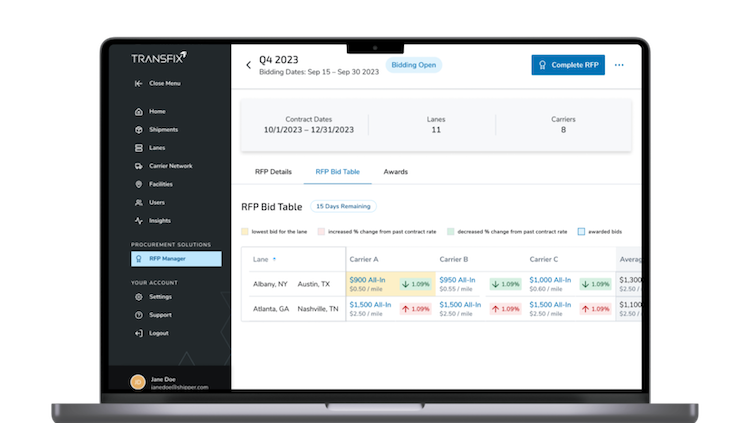According to 2023 research, the majority of shippers still run procurement using manual processes like spreadsheets and emails; similarly, a leading research consultancy describes the current procurement technologies on the market as “fragmented” and “difficult to navigate.”
A year ago, Transfix set out to modernize the RFP process. At the core of our development plan was customer research. Among many data points, we examined how shippers are currently approaching the RFP process for freight procurement, the drawbacks associated with each option, and the questions shippers should be asking themselves when choosing a technology partner.
Spreadsheets and Emails: The Hidden Costs of Manual Processes
Manual RFP approaches are labor-intensive, time-consuming, and prone to errors. Industry research has shown that it can take shippers an average of eight weeks to complete a freight RFP, and many identify the general process as a problem area. Further, these old methods lack the agility required to respond to sudden market shifts and don't offer the level of visibility and control modern shippers need.
Some common RFP issues that can arise include:
- Excessive time and effort: Using antiquated processes requires a hefty time investment to manage the RFP cycle.
- Problematic communications: Back and forth with bidders via email (for bid communication, rate negotiations, etc.), takes time and is prone to errors, particularly when confirming lane rates.
- Lack of a single source of truth & team bottlenecks: When multiple team members are managing communications and collecting information, their individual sources are not easily compiled to create routing guides. Some shippers have a single individual responsible for running RFPs to secure rates, making the RFP data difficult to centralize for team use. Without a centralized source of truth, teams may lose sight of contracted lanes and rates, resulting in excess time spent sourcing capacity.
- Difficult Analyses: Compiling bids from multiple sources into a single spreadsheet to analyze prices can often lead to error, as it doesn’t allow shippers to layer in other data points (e.g., service metrics). Without data insights to provide better market transparency, shippers may struggle to evaluate if they are getting the ‘best’ rate.
- Information Silos and Individual Dependencies: When/if individuals leave transportation and logistics teams, their institutional knowledge is often lost and new processes have to be spun up, creating further inefficiencies and resulting in less intelligent awards.
Freight Procurement Software
Recently, tech-forward shippers have started to utilize freight procurement software and/or a TMS that purports to resolve many of the aforementioned problems. But, not all software is created equal; and therefore, not all software will deliver procurement teams the solutions to their particular RFP challenges. Some existing software solutions for shippers offer designs that attempt to weave together different products, often resulting in an inefficient workflow— meanwhile general procurement software (not designed for freight) is not designed to handle the complexities of logistics.
So the question remains, what features should shippers look for in their freight procurement software?
- Designed for Logistics: Due to the complexities of the freight market, general procurement software often does not address the needs of transportation teams. Shippers should pick a software solution that’s designed specifically for logistics and that allows them to collect more data from their bidders for a smoother, more integrated process.
- User Experience: Some solutions on the market have been created as a ‘band-aid solution,’ more so than a permanent one. These solutions don’t result in a cohesive workflow, and instead, provide transportation teams with a suite of disjointed products that will cause more friction when converting to a new, more long-term system. Shippers should opt for software with an intelligent user experience that works for their transportation team, not against.
- Integration: Similarly, shippers should look for solutions that are adaptable to their current processes and existing systems. Some existing and upcoming freight procurement software packages are not well integrated with other products, siloing RFP data from TMSs. Shippers that are satisfied with their current TMS may opt to pick software that can integrate their data from procurement to tendering.
- Speed to Market: RFPs can be a very time consuming process, but with the right software, shippers can seamlessly turn around RFPs and receive contract prices as quickly as needed.
- Data Insights: Freight procurement software aimed at providing efficient solutions to shippers should go beyond simply presenting bids. Shippers should select software that provides insights into bidder service metrics, provide price comparisons, and more.
Given these product insights and recent conversations with shippers, Transfix put itself to the test to create a procurement tool that not only addresses those requirements, but sets a new standard for freight procurement tech.
Coming Soon: Transfix’s RFP Manager
RFP Manager, set to launch in mid-November, is the latest product within the Transfix Shipper App, designed to streamline FTL procurement. With RFP Manager, shippers can turn around an RFP in as little as a few hours, make informed decisions with lane-level pricing insights and carrier service metrics, and centralize data for their transportation teams.
Our software was specifically built for freight procurement to help transportation teams seamlessly execute their RFPs from concept to completion within the Transfix Shipper App. Request a demo for RFP Manager and learn how you can get free access here.



